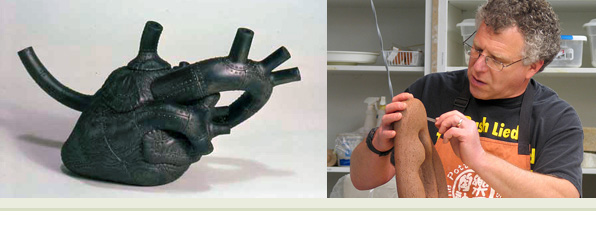Richard Notkin is a ceramic sculptor. He is well known for his socio-critical tile mural ‘The Gift’ and his sculptural re-interpretations of the Yixing teapot, e.g. his ‘Curbside Teapot’ of 1986. Notkin is on the board of the Archie Bray Foundation. He has won several awards, including National Endowment for the Arts Visual Arts Fellowships in 1981 and 1988, the Louis Comfort Tiffany Foundation Award in 1991 and a Jerry Metcalf Foundation Artist Fellowship in 1999.
More InformationWhat advice would you give a young artist?
Marry a doctor or a lawyer! No, I’m only kidding. I am married to an artist and it works very well because we both realize the commitment of the arts. For MFA graduates, you have to face the reality of how to make a living and continue to make art. There are two roads you can take: you can get a full-time teaching position, or you can decide to become a full-time artist. You have to make that decision right away. I encourage people to not apply for a teaching position right away if they are really passionate about making. If you are young and single, there are benefits to taking advantage of that time immediately after school for developing your own voice. That time is very important, if you can take 2-5 years and only make art. The benefits are that you can set your own goals and raise the bar for yourself outside of the structured school environment. Everyone is different though, and each individual has to know what works for them. I am speaking only from my personal experience.
What have you done to help you get where you are?
I made a career right out of graduate school. I didn’t apply for a single job. I wanted to maximize my time in the studio, pursuing my own aesthetic. My wife is a painter, and we both got jobs two nights a week teaching an adult education classes, and this was enough to cover our bills. I used the garage as my studio and we converted our living room into a painting studio for her. We simply utilized the space that we had for making art. Because we were both teaching two nights a week to generate income, we had our days free for art making. I fell in love with that lifestyle.
In your lifetime opportunity will knock. For me it was [one] year later. My teacher, Robert Arneson, came unannounced to my studio and asked me to be in this show in New York. Because at that point I had my time committed to making in the studio, at that moment, I had the work! If you really want to be an artist you have to put in that time. Time is the artist’s most important commodity. Time is a tool, like another material. You have to structure your life to maximize you studio time.
Stay on a student economic level for a while; money is a corrupting influence. That will all come with time.
What was most difficult for you when you finished school?
I don’t know if there were any difficulties. I was so enamored with making art. We had just enough, and I thought I was in heaven. I had great passion, conviction, and commitment to what I was doing. When you are out of school, the structure is up to you as far as what kind of work you want to be making. Avoid difficulties, and chose to do work that you personally are passionate about. It is important to maintain that passion by asking yourself questions about the connection between you and your work. When people finish school they think they are done being students. An artist is always a student, that’s what makes art viable. You have to remain a student your whole life so you won’t get stagnate. For me having deep personal convictions and developing my own aesthetic is what kept it exciting. If you find one technique you are good at and you keep doing it forever, you’re like a factory, and you will burn out. You have to push your limits, just like when you’re in school and experimenting. You can’t make the best piece every day.
Which do you find exerts a stronger influence on your work, success or failure?
You have to be able to learn from both, that’s part of being a student and a self-motivated student. What I do is spend time in the gallery with my own work. I ask myself questions, and do a self-critique, take notes. This is the springboard for my next body of work. It is important to become the best self-critic, to record those things.
Could you comment on having a vision and what it means to be an artist?
It is an artist’s responsibility to express something that people want to see over and over again. It is what is deep inside of you. Find meaningful dialogue with artists who you can have in-depth dialogue with about your work and theirs. This will be a lifetime dialogue on the very deepest level that challenges all who are involved.
Ask yourself questions. Does this engage people? You are an artist first, and it is important that your concept and technique go hand in hand and are equally as strong as the other. True passion doesn’t disappear; take your emotions and turn them into creative energy. Human beings are a creative species, and artists give people things to marvel about. Be engaged in keeping the species moving, imagine a world without art, and take the broader view that artists sustain themselves. So ask yourself, why do we make art? Why me, and why this work?
